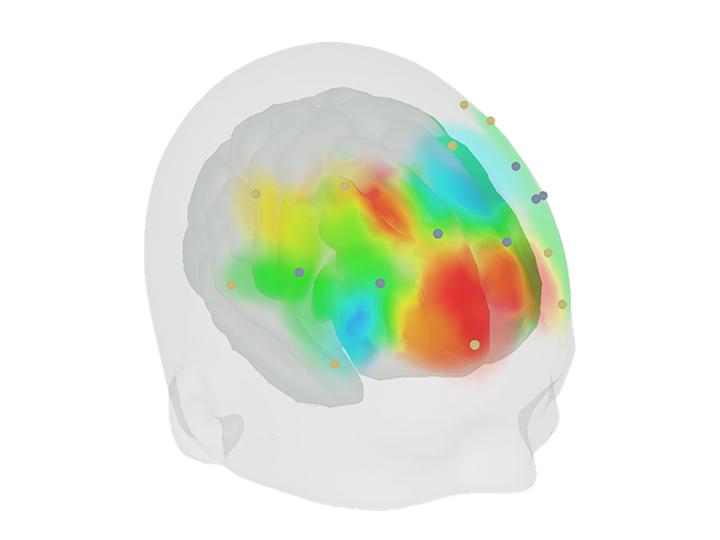Prefrontal cortex
Last updated on
2022-09-07

fNIRS stands for functional near infrared spectroscopy. The functional component comes from the fact that our fNIRS devices are capable of assessing brain activity. This is done by measuring changes in oxyhemoglobin and deoxyhemoglobin, which reflect local brain activity. Moreover, fNIRS provides a non-invasive manner to achieve an excellent resolution brain signal in real-time.
Publications
Effect of Dynamic Balance Training Combined with Different Intensities of Cerebellar Transcranial Direct Current Stimulation in People with Parkinson’s Disease: a Randomized Clinical Trial
Impaired balance is one of the most disabling symptoms in people with Parkinson’s disease (PwPD). While motor intervention can improve …
Study protocol of a randomised controlled trial of the effects of near-infrared spectroscopy neurofeedback training coupled with virtual reality technology in children with ADHD
Background The rise in the number of children diagnosed with attention-deficit/hyperactivity disorder (ADHD) highlights the need for …
Prefrontal cortex activity during virtual obstacle avoidance and distracted walking: A methodological proof of concept using augmented reality and functional near-infrared spectroscopy
Introduction There is an established interplay between gait and attention allocation. Attention during walking is important to reduce …
The effect of transcranial pulse current stimulation on the accumulation of exercise-induced fatigue in college students after moderate intensity exercise evidence from central and peripheral sources
Objective: To investigate the intervention effect of cranial pulse current stimulator (tPCS) on fatigue accumulation after …
Ecological functional near-infrared spectroscopy in mobile children: using short separation channels to correct for systemic contamination during naturalistic neuroimaging
Significance The advances and miniaturization in functional near-infrared spectroscopy (fNIRS) instrumentation offer the potential to …
Efectos del Entrenamiento Respiratorio de Fuerza versus Resistencia sobre la Desoxigenación Tisular inducida por Ejercicio de Alta Intensidad en Atletas de Resistencia Aeróbica
Introducción. El entrenamiento de músculatura respiratoria (EMR) aminora los efectos negativos del reflejo metabólico sobre el …
The Use of Functional Near-Infrared Spectroscopy (fNIRS) for Monitoring Brain Function, Predicting Outcomes, and Evaluating Rehabilitative Interventional Responses in Poststroke Patients with Upper Limb Hemiplegia: A Systematic Review
Functional near-infrared spectroscopy (fNIRS) has been increasingly applied in poststroke research. The accumulated evidence in this …
Atypical prefrontal neural activity during an emotional interference control task in adolescents with autism spectrum disorder: A functional near-infrared spectroscopy study
Autism spectrum disorder (ASD) is typically characterized by impairments in social interaction and communication, which may be …
Boys vs men differences in muscular fatigue, muscle and cerebral oxygenation during maximal effort isometric contractions: the effect of muscle blood flow restriction
Purpose To examine whether the children’s superiority, over adults, to resist fatigue during repeated maximal-efforts depends on their …
Functional Clustering of Systolic Blood Pressure and Frontal Brain Oxygenation During an Active Stand Test in The Irish Longitudinal Study on Ageing (TILDA): A Comparison of Tissue Saturation Index Versus Absolute Oxygenated Hemoglobin Concentration Approaches
Understanding the clinical implications of combined patterns of blood pressure and brain oxygenation dynamics during the transition …
Effectiveness of a game-based high-intensity interval training on executive function and other health indicators of children with ADHD: A three-arm partially-blinded randomized controlled trial
Background Children with ADHD demand for effective intervention with minimum side effect to improve executive function (EF) and health …
Is virtual reality-based cognitive training in parallel with functional near-infrared spectroscopy-derived neurofeedback beneficial to improve cognitive function in older adults with mild cognitive impairment?
Purpose Cognitive training in parallel with functional near-infrared spectroscopy (fNIRS)-derived neurofeedback has been identified to …
Effects of a One-Day Experiential Sheep-Rearing Experience on Motivation, Anxiety, and Frontal Lobe Brain Activity in Patients with Chronic Psychiatric Disorders: A Crossover Pilot Study
The purpose of this study was to investigate the effects of a one-day sheep-rearing experience on motivation and anxiety levels in …
Near Infrared Spectroscopy (NIRS) Observation of Vastus Lateralis (Muscle) and Prefrontal Cortex (Brain) Tissue Oxygenation During Synchronised Swimming Routines in Elite Athletes
The development of underwater Near-Infrared Spectroscopy (uNIRS) has enabled the measurement of tissue oxygenation within the swim …
Were Frailty Identification Criteria Created Equal? A Comparative Case Study on Continuous Non-Invasively Collected Neurocardiovascular Signals during an Active Standing Test in the Irish Longitudinal Study on Ageing (TILDA)
Background: In this observational study, we compared continuous physiological signals during an active standing test in adults aged 50 …
Prefrontal cortex hemodynamic activity during a test of lower extremity functional muscle strength in children with cerebral palsy: A functional near‐infrared spectroscopy study
Abstract Children with cerebral palsy (CP) exhibit impaired motor control and significant muscle weakness due to a brain lesion. …
The Effects of Distancing Design Collaboration Necessitated by COVID-19 on Brain Synchrony in Teams Compared to Co-Located Design Collaboration: A Preliminary Study
Due to the widespread involvement of distributed collaboration triggered by COVID-19, it has become a new trend that has continued into …
At-home computerized executive-function training to improve cognition and mobility in normal-hearing adults and older hearing aid users: a multi-centre, single-blinded randomized controlled trial
Abstract Background Hearing loss predicts cognitive decline and falls risk. It has been argued that degraded hearing makes listening …
Functional Analysis of Continuous, High-Resolution Measures in Aging Research: A Demonstration Using Cerebral Oxygenation Data From the Irish Longitudinal Study on Aging
Background: A shift towards the dynamic measurement of physiologic resilience and improved technology incorporated into experimental …
Brain activation associated with low‐ and high‐intensity concentric versus eccentric isokinetic contractions of the biceps brachii: An textlessspan style="font-variant:small-caps;"textgreaterfNIRStextless/spantextgreater study
Abstract Studies have shown that neural responses following concentric (CON) and eccentric (ECC) muscle contractions are different, …
Operational Modal Analysis of Near-Infrared Spectroscopy Measure of 2-Month Exercise Intervention Effects in Sedentary Older Adults with Diabetes and Cognitive Impairment
The Global Burden of Disease Study (GBD 2019 Diseases and Injuries Collaborators) found that diabetes significantly increases the …
C-STIM: Protocol for a randomized, single-blind, crossover study of cerebellar repetitive transcranial magnetic stimulation (rTMS) for postural instability in people with progressive supranuclear palsy (PSP)
Background Methods for modulating the cerebellum with transcranial magnetic stimulation (TMS) are well established, and preliminary …
The Effect of Skeletal Muscle Oxygenation on Hemodynamics, Cerebral Oxygenation and Activation, and Exercise Performance during Incremental Exercise to Exhaustion in Male Cyclists
This study aimed to elucidate whether muscle blood flow restriction during maximal exercise is associated with alterations in …
Transcranial direct current stimulation over the right dorsolateral prefrontal cortex increases oxyhemoglobin concentration and cognitive performance dependent on cognitive load
Transcranial direct current stimulation (tDCS) has been explored as a potential method for cognitive enhancement. tDCS may induce a …
Load-Dependent Prefrontal Cortex Activation Assessed by Continuous-Wave Near-Infrared Spectroscopy during Two Executive Tasks with Three Cognitive Loads in Young Adults
The present study examined the evolution of the behavioral performance, subjectively perceived difficulty, and hemodynamic activity of …
Analgesic Electrical Stimulation Combined with Wrist-ankle Acupuncture Reduces the Cortical Response to Pain in Patients with Myofasciitis: A Randomized Clinical Trial
Abstract Objective Transcutaneous electrical nerve stimulation (TENS) based on wrist-ankle acupuncture has been shown to relieve pain …
Cerebral Autoregulation Assessment Using the Near Infrared Spectroscopy ‘NIRS-Only’ High Frequency Methodology in Critically Ill Patients: A Prospective Cross-Sectional Study
Impairments in cerebral autoregulation (CA) are related to poor clinical outcome. Near infrared spectroscopy (NIRS) is a non-invasive …
Effects of acute moderate‐intensity aerobic exercise on executive function and prefrontal cortex activity in community‐dwelling older adults: A single‐blind, randomized controlled trial
Aim To date, there is a controversy regarding the effects of acute aerobic exercise of moderate intensity on executive function and …
The association between generalized anxiety disorder and resting-state prefrontal cortex oxygenation is modified by self-reported physical activity: results from The Irish Longitudinal Study on Ageing
Individuals with anxiety disorders exhibit lower intrinsic functional connectivity between prefrontal cortical areas and subcortical …
An optical window into brain function in children and adolescents: A systematic review of functional near-infrared spectroscopy studies: fNIRS in developmental cognitive neuroscience
Despite decades of research, our understanding of functional brain development throughout childhood and adolescence remains limited due …
Identification of the cognitive interference effect related to stroop stimulation: Using dynamic causal modeling of effective connectivity in functional near-infrared spectroscopy (fnirs)
Background: The Stroop test is a well-known model to denote the decline in performance under the incongruent condition, which requires …
Impact of carbohydrate ingestion on cognitive flexibility and cerebral oxygenation during high-intensity intermittent exercise: A comparison between maple products and usual carbohydrate solutions
Background: The aim of this study was to compare the effects of carbohydrate (CHO) drinks (6% per volume) sweetened with maple (syrup …
Functional near infrared spectroscopy (fNIRS) in pigmented subjects: a maneuver to confirm sufficient transcutaneous photon transmission for measurement of hemodynamic change in the anterior cortex
© 2019 SPIE Background: A requisite for fNIRS studies of cortical blood flow is that sufficient photons are transmitted …
Acute effects of combined Bacopa, American ginseng and whole coffee fruit on working memory and cerebral haemodynamic response of the prefrontal cortex: a double-blind, placebo-controlled study
Objective: This study assessed whether a multi-ingredient herbal supplement containing Bacopa monniera (BM), Panax quinquefolius …
Oral nitrate supplementation differentially modulates cerebral artery blood velocity and prefrontal tissue oxygenation during 15 km time-trial cycling in normoxia but not in hypoxia
Background: Nitrate is a precursor of nitric oxide (NO), an important regulator of cerebral perfusion in normoxic and hypoxic …
Mp27-19 a New Clinical Protocol for Demonstration of Cortical Brain Activity Mapping During Voluntary Uroflow and Pelvic Floor Muscle Activity Using Functional Near Infra-Red Spectroscopy (Fnirs)
INTRODUCTION AND OBJECTIVES: Control of micturition is dependent upon an extensive brain neural network. Cortical activity related to …
The reliability and minimal detectable change of the cardiovascular response and self-selected exercise intensity during forward and backward treadmill exercise in individuals with Parkinson disease
OBJECTIVE This study examined test-retest relative (intraclass correlation coefficient) and absolute (minimum detectable change) …
Multivitamins and minerals modulate whole-body energy metabolism and cerebral blood-flow during cognitive task performance: A double-blind, randomised, placebo-controlled trial
Background: The brain is by far the most metabolically active organ in the body, with overall energy expenditure and local blood-supply …
Changes in oxygenated hemoglobin link freezing of gait to frontal activation in patients with Parkinson disease: an fNIRS study of transient motor-cognitive failures
Recent studies have suggested that deficits in executive function contribute to freezing of gait (FOG), an episodic disturbance common …
Effect of end-tidal CO 2 clamping on cerebrovascular function, oxygenation, and performance during 15-km time trial cycling in severe normobaric hypoxia: the role of cerebral O 2 delivery
During heavy exercise, hyperventilation-induced hypocapnia leads to cerebral vasoconstriction, resulting in a reduction in cerebral …
